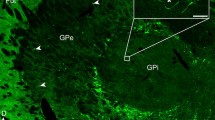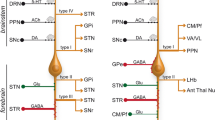Summary
Anatomical studies in several species have demonstrated a pallidostriatal pathway. We employed electrophysiological and anatomical methods to distinguish the neurones of this pathway from the two pallidocortical groups reported in the rat. Injection of fluorescent retrograde tracers, combined with immunohistochemistry for choline acetyltransferase, provided anatomical evidence of the distinction between neurones of the cholinergic pallidocortical projection and pallidal cells retrogradely labelled from the striatum. Extracellular recordings made in the globus pallidus of halothane-anaesthetised rats provided an electrophysiological description of the pallidostriatal pathway. In some animals neurones of this pathway were distinguished from pallidocortical neurones as a stimulating electrode, situated in the crus cerebri, permitted identification of neurones which projected through this region as well as to the striatum. Neither pallidocortical pathway is reported to have descending axons travelling in the crus cerebri at this point. A preliminary electrophysiological study was carried out in rats in which the dopamine-containing cells of substantia nigra had been destroyed by injections of 6-hydroxydopamine at least 6 months prior to the recording. In the globus pallidus on the lesioned side the mean firing rate of neurones was increased compared with controls. No specific change in firing pattern was noted but the neurones were more responsive to striatal stimulation suggesting that long-term dopamine denervation alters the sensitivity of neurones of globus pallidus.
Similar content being viewed by others
References
Arbuthnott GW, Wright AK (1982) Some non-fluorescent connections of the nigro-neostriatal dopamine neurones. Brain Res Bull 9: 367–378
Arbuthnott GW, Donnelly S, Whale D (1984) Realtime computing of neurophysiological data. J Physiol 346: 20P
Arbuthnott GW, Walker RH, Whale D, Wright AK (1983) Further evidence for a pallidostriatal pathway in rat brain. J Physiol 336: 33P
Arbuthnott GW, MacLeod NK, Brown JR, Wright AK, Rutherford A, Ryman A (1987) The action of 6-OH-dopamine on the striatonigral cells in the rat. In: Chalazonitis N, Gola M (eds) Neurology and neurobiology, Vol 28. Inactivation of hypersensitive neurons. Alan R Liss, Inc, New York, pp 223–232
Ashton-Jones G, Shaver R, Dinan TG (1985) Nucleus basalis neurons exhibit axonal branching with decreased impulse conduction velocity in rat cerebrocortex. Brain Res 325: 271–285
Bergstrom DA, Walters JR (1981) Neuronal responses of the globus pallidus to systemic administration of d-amphetamine: investigation of the involvement of dopamine, norepi- nephrine, and serotonin. J Neurosci 1: 292–299
Bergstrom DA, Bromley SE, Walters JR (1984) Dopamine agonists increase pallidal unit activity: alteration by agonist pretreatment and anaesthesia. Eur J Pharmacol 100: 3–12
Filion M (1979) Effects of interruption of the nigrostriatal pathway and of dopaminergic agents on the spontaneous activity of globus pallidus neurons in the awake monkey. Brain Res 178: 425–441
Filion M, Tremblay L, Bedard PJ (1986) Responses of globus pallidus neurons to electrical stimulation of striatum and the passive joint rotation in MPTP treated monkeys. Abstracts of 12th Society for Neuroscience Meeting, Vol 1, P 208 60.9
Filion M, Tremblay L, Bedard PJ (1988) Abnormal influences of passive limb movement on the activity of globus pallidus neurons in parkinsonian monkeys. Brain Res 444: 165–176
Garcia-Munoz M, Nicolaou NM, Tulloch IF, Wright AK, Arbuthnott GW (1977) Striato-nigral fibres — feedback loop or output pathway? Nature 265: 363–365
Graybiel AM, Ragsdale CW Jr (1978) Histochemically distinct compartments in the striatum of human, monkey and cat demonstrated by acetylthiocholinesterase staining. Proc Natl Acad Sci 75: 5723–5726
Hefti F, Melamed E, Wurtman RJ (1980) Partial lesions of the dopaminergic nigrostriatal system in rat brain: biochemical characterization. Brain Res 195: 123–127
Jayaraman A (1983) Topographic organization and morphology of peripallidal and pallidal cells projecting to the striatum in cats. Brain Res 275: 279–286
Levine MS, Hull CD, Buchwald NA (1974) Pallidal and entopeduncular intracellular responses to striatal, cortical, thalamic and sensory inputs. Exp Neurol 44: 448–460
Mettler FA (1943) Extensive unilateral cerebral removals in the primate: physiological effects and resultant degeneration. J Comp Neurol 79: 185–245
Miller WC, Delong MR (1987) Altered tonic activity of neurons in the globus pallidus and subthalamic nucleus in the primate MPTP model of parkinsonism. In: Carpenter MB, Jayaraman A (eds) The basal ganglia: structure and function, II. Plenum Press, New York, pp 415–429
Nakanishi H, Hori N, Kastuda N (1985) Neostriatal evoked inhibition and effects of dopamine on globus pallidal neurons in rat slice preparations. Brain Res 358: 282–286
Nauta HJW (1979) Projections of the pallidal complex: an autoradiographic study in the cat. Neuroscience 4: 1852–1873
Nauta WJH, Mehler WR (1966) Projections of the lentiform nucleus in the monkey. Brain Res 1: 3–42
Park MR, Falls WM, Kitai ST (1982) An intracellular HRP study of the rat globus pallidus. I. Responses and light microscopic analysis. J Comp Neurol 211: 284–294
Paxinos G, Watson C (1986) The rat brain in stereotaxic coordinates, 2nd edn. Academic Press, Sydney
Percheron G, Yelnik J, François C (1984) A Golgi analysis of the primate globus pallidus. III. Spatial organization of the striatopallidal complex. J Comp Neurol 227: 214–227
Perkins MN, Stone TW (1981) Iontophoretic studies on pallidal neurones and the projection from the subthalamic nucleus. Q J Exp Physiol 66: 225–236
Reiner PB, Semba K, Fibiger HC, McGeer EG (1987) Physiological evidence for subpopulations of cortically projecting basal forebrain neurons in the anaesthetised rat. Neuroscience 20: 629–636
Schultz W, Ungerstedt U (1978) Short-term increase and longterm reversion of striatal cell activity after degeneration of the nigrostriatal dopamine system. Exp Brain Res 33: 159–171
Staines WA, Atmadja S, Fibiger HC (1981) Demonstration of a pallidostriatal pathway by retrograde transport of HRP labelled lectin. Brain Res 206: 446–450
Staines WA, Fibiger HC (1984) Collateral projections of neurons of the rat globus pallidus to the striatum and substantia nigra. Exp Brain Res 56: 217–220
Takada M, Ng G, Hattori T (1986) Single pallidal neurons project to both the striatum and the thalamus in the rat. Neurosci Lett 69: 217–220
Toan DL, Schultz W (1985) Responses of rat pallidum cells to cortex stimulation and effects of altered dopaminergic activity. Neuroscience 15: 683–694
van der Kooy D, Hattori T, Shannack K, Hornykiewicz O (1981) The pallido-subthalamic projection in rat: anatomical and biochemical studies. Brain Res 204: 253–268
van der Kooy D, Kolb B (1985) Non-cholinergic globus pallidus cells that project to the cortex but not to the subthalamic nucleus in rat. Neurosci Lett 57: 113–118
Wilson CJ, Phelan KD (1982) Dual topographic representation of neostriatum in the globus pallidus of rats. Brain Res 243: 354–359
Wilson SAK (1911) An experimental research into the anatomy and the physiology of the corpus striatum. Brain 34: 295–509
Yoshida M, Rabin A, Anderson ME (1972) Two types of monosynaptic inhibition of pallidal neurons produced by stimulation of the diencephalon and substantia nigra. Exp Brain Res 15: 333–347
Author information
Authors and Affiliations
Additional information
RHW was funded by a Scottish Home and Health Department grant and by a research fellowship from the University of Edinburgh Faculty of Medicine
Rights and permissions
About this article
Cite this article
Walker, R.H., Arbuthnott, G.W. & Wright, A.K. Electrophysiological and anatomical observations concerning the pallidostriatal pathway in the rat. Exp Brain Res 74, 303–310 (1989). https://doi.org/10.1007/BF00248863
Received:
Accepted:
Issue Date:
DOI: https://doi.org/10.1007/BF00248863




